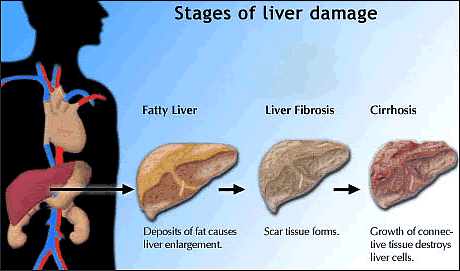Moderate
Liver Fibrosis Predicts Disease and Death in HIV/HCV Coinfected People,
but Successful Treatment Appears Protective
 |
 |
 |
 |
 |
 |
 |
| SUMMARY:
Even moderate liver fibrosis (greater than stage F1) in HIV/HCV
coinfected patients is associated with adverse clinical outcomes
including liver cancer, liver failure, and death, investigators
reported at the 17th Conference on Retroviruses & Opportunistic
Infections (CROI 2010) last week
in San Francisco. However, effective HIV
treatment producing long-term viral suppression and successful
hepatitis C treatment
leading to sustained virological response appeared to be protective.
|
|
 |
 |
 |
 |
 |
 |
 |
By
Liz Highleyman
Over years
or decades, chronic hepatitis C virus
(HCV) infection can progress to advanced liver disease, including
cirrhosis and
liver cancer.
Progression tends to be more rapid in HIV/HCV
coinfected individuals, especially those with low CD4 cell counts.
Only people
who experience liver disease progression need hepatitis C treatment,
but this is not easy to monitor. Liver biopsies are recommended for
disease staging in HIV/HCV coinfected patients, but the degree to which
histological stage predicts clinical outcomes is unclear.
Mark Sulkowski
from Johns Hopkins University and colleagues conducted a study to prospectively
assess clinical outcomes and mortality according to hepatic fibrosis
stage in a cohort of well-characterized HIV/HCV coinfected adults.
The researchers
hypothesized that patients with significant liver
fibrosis (Metavir stage F2 or higher) would be more likely to progress
to end-stage liver disease (ESLD), hepatocellular
carcinoma (HCC), or death.

The study
included 637 HIV/HCV coinfected patients seen at the Johns Hopkins HIV
clinic between July 1993 and March 2009. A majority (67%) were men,
most (80%) were black, and the median age was about 46 years. Three-quarters
had a history of injection drug use and about half had a history of
heavy alcohol use. Almost all (94%) had hard-to-treat HCV
genotype 1.
With regard to HIV disease, 64%
were on combination antiretroviral
therapy (ART), 56% had undetectable HIV viral load, one-third had
a well-preserved CD4 cell count of 500 cells/mm3 or more, but 18% had
less than 200 cells/mm3.
Liver biopsies were performed at baseline, evaluated by a single pathologist
and scored using the Metavir system. Over a median follow-up duration
of about 5 years, clinical outcomes were abstracted from medical records
and national death databases. The primary endpoint was the combined
outcome of progression to ESLD, HCC, or death since the baseline biopsy.
Results
 |
The
distribution of METAVIR fibrosis stages was as follows: |
| |
 |
F0
(absent fibrosis): 32%; |
 |
F1
(mild portal fibrosis): 41%; |
 |
F2
(significant fibrosis, few septa): 9%; |
 |
F3
(advanced fibrosis, many septa): 7%; |
 |
F4
(cirrhosis): 11%. |
|
 |
The
incidence rate of ESLD, HCC, or death was significantly higher among
patients with fibrosis stage > F1 compared to those with F0-F1. |
 |
Incidence
rates for the combined endpoint of ESLD, HCC, and death were as
follows: |
| |
 |
F0:
20.9 per 1000 person-years; |
 |
F1:
26.8 per 1000 person-years; |
 |
F2:
50.1 per 1000 person-years; |
 |
F3:
59.2 per 1000 person-years; |
 |
F4:
71.4 per 1000 person-years. |
|
 |
After
adjusting for confounding factors including age, sex, race, injection
drug use, and control of HIV disease (HIV RNA level and CD4 cell
count), stage F1 fibrosis was not significantly associated with
more adverse outcomes, but all higher stages were: |
| |
 |
F1:
incidence rate ratio (IRR) 1.23 (P = 0.441); |
 |
F
2: IRR 2.29 (P = 0.009); |
 |
F3:
IRR 2.29 (P = 0.024); |
 |
F4:
IRR 3.12 (P > 0.0001); |
|
 |
Among
participants who received hepatitis C treatment, the sustained virological
response (SVR) rate was only about 15%; this is lower than many
other studies, but the population was "hard to treat,"
having mostly HCV genotype 1 and most being black (a group that
does not respond as well to interferon). |
 |
Patients
who achieved SVR experienced fewer clinical outcomes or death than
either non-responders or untreated individuals: |
 |
 |
F0-F1
patients: |
| |
 |
No
treatment: 26.86 per 1000 person-years; |
 |
Non-response:
22.08 per 1000 person-years; |
 |
Relapse:
0 per 1000 person-years; |
 |
SVR:
0 per 1000 person-years. |
|
 |
F2-F4
patients: |
| |
 |
No
treatment: 82.38 per 1000 person-years; |
 |
Non-response:
57.02 per 1000 person-years; |
 |
Relapse:
21.92 per 1000 person-years; |
 |
SVR:
0 per 1000 person-years. |
|
|
 |
Maintaining
good HIV control (CD4 cell count of 200-350 or > 350 cells/mm3
and 75% of HIV RNA levels < 400 copies/mL), as well as not having
a history of injection drug use, were independently associated with
a decreased incidence of clinical events or death. |
Based
on these results, the researchers concluded, "Coinfected patients
with more than portal fibrosis (F1) are at increased risk of clinical
outcomes."
"Liver
disease staging should be routine," they recommended. "Effective
treatment of HIV (long-term suppression) and HCV (SVR) appeared to be
protective."
Discussing
these findings, Dr Sulkowski noted that individuals with stage F0-F1
fibrosis were not a zero risk for progression, but that this happened
less often or more slowly. He suggested that perhaps 25% of people at
these stages will progress probably driving the observed risk in the
F0-F1 group while the remainder will have sustained absent or mild fibrosis.
Johns
Hopkins University, Baltimore, MD.
2/26/10
Reference
M
Sulkowski, S Mehta, C Sutcliffe, and others. Baseline Liver Disease
Is Independently Associated with Risk of Death among 631 HIV/HCV Co-infected
Adult with Histologic Staging. 17th Conference on Retroviruses &
Opportunistic Infections (CROI 2010). San Francisco. February 16-19,
2010. Abstract 166.